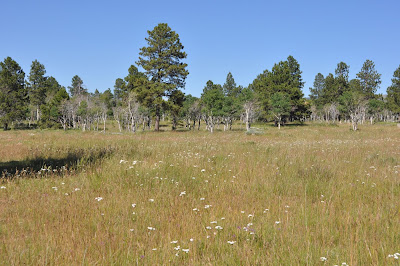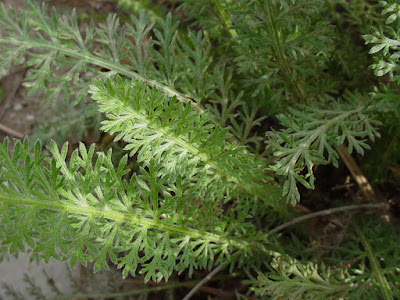 |
| Western (Common) Yarrow (Achillea millefolium): good plant for fall |
November
can be interesting in Western Colorado; you just never know what the weather
will bring. Last year we’d already had
several snows in Mother Nature’s Montrose Garden by early November. This year it’s been unusually warm, leading
to a great display of seasonal color. Next year, who knows!
Planning
an interesting November garden can be a challenge, given such unpredictable conditions.
Some of our best choices are plants that are hardy (and therefore stay green
longer into the cold season) but also add interest in their dormant state. One such plant is our Plant of the Month,
Western Yarrow or Achillea millefolia. The
scientific name is pronounced uh-KILL-ee-uh mill-ee-FOH-lee um.
 |
| Western (Common) Yarrow (Achillea millefolium):in wild Uncompahgre Plateau, Western Colorado |
Yarrow grows throughout the western U.S., from the West
coast to the Great Basin and Rocky Mountains. It grows in most of the western
and central Colorado counties, but is uncommon or absent in the eastern Colorado
plains. You’ll find it in numerous plant
communities from the coastal strand of the Pacific to high mountain meadows (to
13,000 ft. in Colorado) and coniferous forests. In the wild it often grows in open meadows
and grasslands along with native grasses, perennial herbs and bulbs (above). It often forms a natural groundcover
between/beneath taller plants.
 |
| Western (Common) Yarrow (Achillea millefolium):growth habit |
Yarrow is an herbaceous perennial that is 1-2 ft. tall and wide. In the first year or two it forms a mounded clump (above). But Yarrow spreads horizontally via rhizomes (horizontal underground stems), forming larger clumps and potentially filling an area.
 |
| Western (Common) Yarrow (Achillea millefolium):flowers |
Yarrow is a member of the Sunflower family (Asteraceae),
which makes sense when you look closely at the flowers. The dense, rather flat flowering clusters are
composed of many tiny ‘sunflowers’ (see above photos). Plants bloom in the warm
season, often from spring into fall. The
flower color is usually white, but there are pastel pink or purple variants
(below), which are the basis for several horticultural varieties
(cultivars). Plant breeders continue to
develop cultivars with flower colors that range from red, rust and orange to
gold and yellow. Some of these are
hybrids with European forms of Yarrow.
 |
| Western (Common) Yarrow (Achillea millefolium):natural color |
 |
| Western (Common) Yarrow (Achillea millefolium): foliage |
The foliage of Yarrow is pretty in its own
right. The leaves are so finely
dissected that they appear feathery or fern-like. They add an interesting texture and medium
green color to the summer garden and are sweetly scented. They also
remain green well into autumn, making them useful in a garden transitioning to
winter.
 |
| Western (Common) Yarrow (Achillea millefolium):contrast in fall garden |
Yarrow is an extremely adaptable garden perennial. It can be grown in most soils (including alkali) and tolerates everything from full sun to part-shade. You can even grow it in quite shady conditions, although it may not flower.
Yarrow is quite drought tolerant due to a relatively
deep, fibrous root system; but it will die back to the ground under very dry
conditions. It stays green from spring
to fall with occasional water (Water Zone 2 or 3) or regular water (Zone 4; see
https://www.slideshare.net/cvadheim/water-zone-gardening).
This makes it a good plant for transitions between regularly watered parts of
the garden (like lawns) and drier areas. We particularly like Yarrow as a
filler plant in newly planted water-wise gardens. It provides needed color while trees and
large shrubs are growing. It becomes a
welcome groundcover once the larger plants mature.
Western (Common) Yarrow (Achillea millefolium): easy-to-grow perennial
Yarrow is easy to grow. We suggest that you taper off watering in fall,
letting the plants die back a bit before winter. Fall is a good time remove plants that have
spread too far – you can be absolutely ruthless tearing it out. You can also mow larger areas of Yarrow in
fall or summer, if desired. Be sure to
set your mower height to high – 4-6 inches – so you don’t damage the plants. After a short dormant period, plants will
begin to grow again in the spring. Spring
is another good time to dig out unwanted plants. You can re-pot these and give them away as
gifts or use them in other parts of the garden.
 |
| Western (Common) Yarrow (Achillea millefolium): tiny seeds |
Both the straight species and Yarrow cultivars are
available as plants at most native plant nurseries. You can also grow Yarrow
quite easily – and inexpensively – from seed, which is readily available from
many native plant seed sources. Seeds can either be sown in prepared beds or grown
up in containers for planting out. When seedling directly into the garden we
suggest planting the seeds in late fall or winter, as seeds benefit from the
cold exposure.
We like to start seed in containers (washed, recycled nursery pots work fine), then transplanting the plants into the garden. Many seed companies give their seeds a cold pre-treatment before shipping. You can also store your seed in a plastic bag in the refrigerator for better germination. Seeds can be planted in outdoor containers from mid- to late spring through early-summer, depending on your climate. The seeds are small, so sprinkle them on the potting soil and lightly cover with additional potting soil. Water them in - then be sure to keep the soil moist until seedlings develop.
 |
| Western (Common) Yarrow (Achillea millefolium): emerging seedlings |
 |
| Western (Common) Yarrow (Achillea millefolium): larger seedlings look more like Yarrow |
Seeds will begin to germinate when the days start
to warm, so don’t give up if your seeds don’t germinate right away. The picture above shows newly germinated
Yarrow seeds. The seedlings will soon
develop leaves that look more Yarrow-like.
In about 2 months they will be ready to transplant into the garden.
 |
| Western (Common) Yarrow (Achillea millefolium): in mixed planting |
So how to use Yarrow in the garden? Let me count
the ways! The flowers are lovely in the summer garden and make nice cut
flowers. It’s a great filler plant around shrubs. You can plant it in a mixed
prairie or meadow planting. Or include Yarrow in more traditional mixed
perennial beds and cottage gardens. Its flowers and foliage add welcome interest
to the fall and winter garden. That’s
one good reason to not cut the plants back in fall. You be glad you waited when
you see the contrast between dried seed heads and winter snow.
 |
| Western (Common) Yarrow (Achillea millefolium): many traditional uses |
Yarrow has many traditional uses. The flowers can be used to make an aromatic
tea. Young leaves can be included in a
salad – they are tart, so use sparingly.
The entire plant can be used as a natural dye plant, producing shades of
yellows and greens. The dried flowers,
foliage and seeds are sweetly scented and can be including in fragrant
potpourri and sachets. They are said to
repel moths, houseflies and ants.
Yarrow has a long history of use as a medicinal
plant. The leaves are effective at
stopping the bleeding from minor cuts and scratches. The whole plant makes a variety of plant
chemicals known to have anti-bacterial and anti-fungal qualities. As with any herbal medicine, you should be sure to learn about the
precautions associated with it. This
plant should be used sparingly, as allergies can develop.
 |
| Western (Common) Yarrow (Achillea millefolium): natural groundcover |
Yarrow is a natural groundcover and can literally
fill an area. This can be either good or
bad, depending on your needs. Yarrow
makes a wonderful groundcover, particularly in those difficult areas under
trees that range from quite sunny to quite shady. It also works well on those
hard-to-maintain slopes. Yarrow can be
cut back – even mowed occasionally to 4-6 inches – to keep it as a non-flowering
groundcover. Or you can mow some areas and leave others to flower. If you don’t want Yarrow to spread, it does
well in pots/containers and planters if you divide it every other year.
 |
| Western (Common) Yarrow (Achillea millefolium): good choice for an edibles garden |
Old time gardeners included Yarrow in or around their edibles gardens. Yarrow is one of the best native plants for attracting beneficial insects and repelling ‘undesirables’. This is one reason why Yarrow was routinely planted – or left as a natural plant – around vegetable gardens and orchards in the past. Plant Yarrow near your vegetable garden and you’ll begin to see the benefits right away. Yarrow is also said to intensify the flavors of herbs planted near it.
 |
| Western (Common) Yarrow (Achillea millefolium): attracts small native pollinators |
Yarrow attracts some the smaller native pollinators
– pollinator flies, small native bees and others. It occupies a habitat niche often not filled
by other flowering plants. Plant it next
to a seating area to watch these small visitors. The seeds of Yarrow provide food for winter
birds. This is another reason to leave the plants unpruned until spring.
 |
| Western (Common) Yarrow (Achillea millefolium): at home in medicinal garden |
In summary, Yarrow is a great native plant for home
gardens, large and small. It’s not only attractive but useful – a boon for those
with small gardens. And it can be used as a lawn substitute or groundcover in
larger gardens. There must be a spot, if
only in a container, for some Yarrow in your garden.
For a
gardening information sheet see: Garden
sheet achillea millefolium (slideshare.net)
For more
pictures of this plant see: https://www.slideshare.net/ConstanceVadheim/achillea-millefolia-web-show-250647951
For plant
information sheets on other native plants see: http://nativeplantscsudh.blogspot.com/p/gallery-of-native-plants_17.html
__________________________________________________________________________
We welcome your comments (below). You can also send your questions to: monaturesmontrosegarden@gmail.com




No comments:
Post a Comment